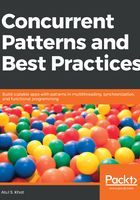
Reactive programming
Reactive programming is a related programming paradigm. A spreadsheet is an excellent example of a reactive application. If we set a formula and change any column value, the spreadsheet program reacts and computes the new result columns.
A message-driven architecture is the foundation of Reactive applications. A message-driven application may be event-driven, actor-based, or a combination of the two.
The following is a diagram of observable composition:

Composable event streams make event handling easier to understand. Reactive Extensions (Rx) is a framework that provides composable observables. At the heart of this framework is the observer pattern, with a functional flavor. The framework allows us to compose multiple observables. The observers are given the resulting event stream in an asynchronous fashion. For more information, see http://reactivex.io/intro.html.
Function of composition is shown in the following code:

This Scala code shows five standalone methods. Each method is converted to a function and then collected in a variable, list. The reduceRightcall iterates over this list and composes all the functions into a bigger one, f.
The f("hello") call shows that the composition has worked!